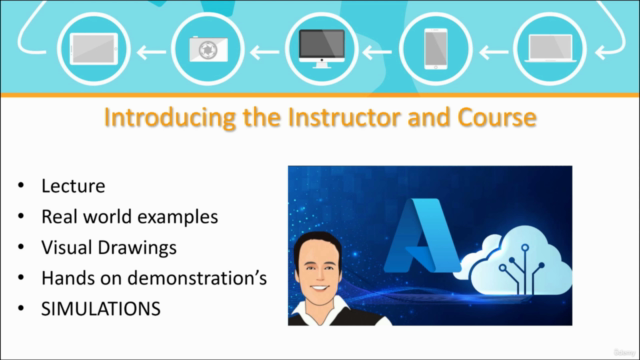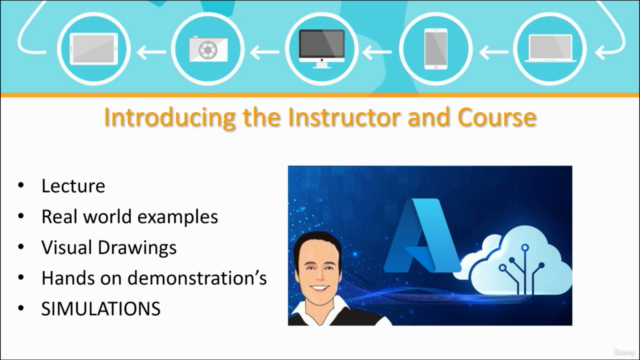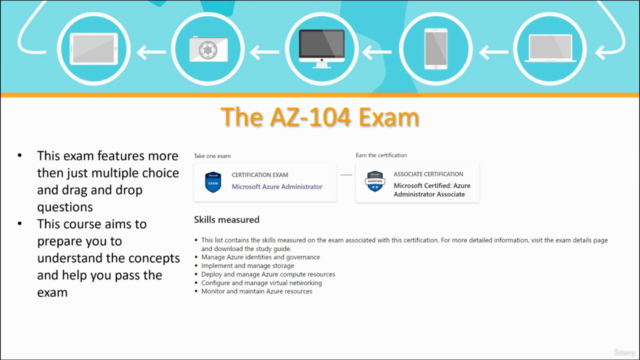AZ-104 Microsoft Azure Administrator course with SIMULATIONS

Why take this course?
Based on the comprehensive list of tasks you've outlined, it seems you are aiming to achieve a deep understanding and hands-on experience with Azure's storage, compute, networking, security, monitoring, backup, and recovery services. Here's how you can approach each area:
-
Azure Storage:
- Start by creating a storage account and familiarizing yourself with its various features, such as Blob, File, Queue, and Table storage.
- Implement Azure Storage firewalls and virtual networks to enhance security.
- Configure Azure AD authentication for your storage account to control access.
- Manage access keys and understand their implications on security.
- Generate SAS tokens and configure stored access policies to secure data access.
- Set up encryption for data at rest in your storage account.
- Use Azure Storage Explorer and AzCopy to manage data.
- Understand Azure Storage redundancy options (LRS, ZRS, GRS, RA-GRS) and implement the one that suits your needs.
- Configure object replication for Blob storage if necessary.
-
Azure Files and Azure Blob Storage:
- Create a file share within your storage account.
- Understand and configure the appropriate storage tier for cost-efficiency.
- Set up blob lifecycle management to automatically manage blobs.
- Enable blob versioning to protect against accidental deletions or overwrites.
-
ARM Templates/Bicep:
- Begin by writing and deploying ARM templates to automate the provisioning of resources.
- Transition to Bicep, Microsoft's domain-specific language for deploying Azure resources declaratively.
- Deploy virtual machine extensions as part of your resource deployment.
-
Virtual Machines:
- Create a VM and understand its components, including disks, networking, and sizes.
- Manage the lifecycle of VMs using Azure services.
- Configure VM firewalls using Network Security Groups (NSGs).
- Explore different types of VMs (e.g., Managed Disks, Accelerated Networking).
-
Networking:
- Set up Azure DNS to manage domain names and resolve names to IP addresses.
- Configure load balancers for high availability and scaling out your applications.
- Understand and implement inbound NAT and SNAT rules as needed.
- Explore Azure Application Gateway for advanced routing and SSL termination.
- Use Azure Network Watcher for network diagnostics and monitoring.
-
Monitoring and Alerts:
- Configure metrics for various Azure services to monitor performance and usage.
- Set up Azure Monitor Logs for deeper insights into system logs.
- Create alerts based on specific conditions or metrics.
- Use VM insights to monitor VMs, storage accounts, and networks.
- Implement Azure Monitor for networks for both Azure and on-premises connectivity.
-
Security:
- Implement Azure Security Center recommendations to enhance the security posture of your resources.
- Configure Azure Bastion for secure and browser-based RDP/SSH connections to VMs.
- Visualize and configure service endpoints and private endpoints for enhanced connectivity security.
-
Backup and Recovery:
- Create a Recovery Services vault to manage backup operations.
- Configure backup policies for Azure resources, such as VMs or SQL databases.
- Perform test restores to ensure that your backups are working correctly.
- Set up Azure Site Recovery for disaster recovery scenarios.
-
Finishing Up:
- Regularly review and refine your configurations based on performance metrics and security recommendations.
- Stay updated with Azure updates and best practices.
- Participate in the Azure community, attend webinars, and take advantage of documentation and training materials.
- Consider obtaining Azure certifications (e.g., AZ-100 or AZ-500) to validate your skills.
By systematically working through each of these areas, you'll build a robust skill set that covers the breadth of Azure services. Remember to start with the basics and gradually move to more complex tasks, ensuring you understand each component before moving on to the next.
Course Gallery




Loading charts...
Comidoc Review
Our Verdict
A valuable AZ-104 Microsoft Azure Administrator course for those specifically preparing for the exam. It offers substantial depth with instructor-led labs and simulations, yet could benefit from more targeted practice tests. Improvements in focus and consistency help ensure a smoother experience for learners. The course will undoubtedly enhance one's familiarity with Azure services administration and is recommended for those willing to adapt to minor drawbacks.
What We Liked
- Tailored for AZ-104 exam preparation with instructor-led labs and simulations
- High-quality content from an experienced instructor, covering Azure services comprehensively
- Accessible hands-on simulations that can be accessed anytime, anywhere
- Clear explanations and a knowledgeable instructor who is passionate about the subject
Potential Drawbacks
- Lack of practice tests for self-assessment and improvement
- Occasionally off-topic background history provided during lessons
- Limited variety in hands-on simulations related to specific sections
- Misnaming or miscalling of resources during demonstrations, causing confusion